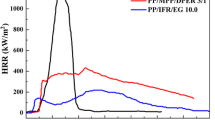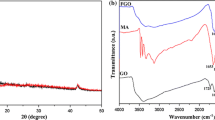Abstract
In this paper, a facile and novel method was adopted in tailoring β-cyclodextrin (CD), which can drastically improve its surface hydrophobicity and decrease its water solubility. By this way, the interfacial compatibility between CD and polypropylene (PP) is distinctly strengthened after modification that is well certified by scanning electron microscope (SEM) and molecular dynamics simulation, respectively. Surprisingly, the flame retardant properties of PP compositing with modified CD (CM) are slightly higher than that of PP/CD. Moreover, the flame retardancy of PP/CM system can be maintained after water treatment. Except that, the synergistic effect of expandable graphite (EG) on the flame retardant properties of PP/melamine phosphate (MP)/CM system were systematically investigated. It can be observed that when the content of EG is 10 wt.%, the flame retardant properties of PP system achieve 31.2 % in limiting oxygen index tests and pass UL-94 V-0 rating in vertical burning tests. And a potential condensed flame retardant mechanism was proposed in detail.


















Similar content being viewed by others
References
Upadhyay RD, Kale DD (2001) Rheological and optical properties of polypropylene filled with synthetic silicates and calcium carbonate. J Polym Res 8(3):175–181
Zhu YL, Liang CS, Yang B et al (2015) Compatibilization of polypropylene/recycled polyethylene terephthalate blends with maleic anhydride grafted polypropylene in the presence of diallyl phthalate. J Polym Res 22:35–46
Peng Y, Liu R, Cao JZ et al (2014) Effects of UV weathering on surface properties of polypropylene composites reinforced with wood flour, lignin, and cellulose. Appl Surf Sci 317:385–392
Song PA, Shen Y, Du BX et al (2009) Effects of reactive compatibilization on the morphological, thermal, mechanical, and rheological properties of intumescent flame-retardant polypropylene. ACS Appl Mater Interfaces 1(2):452–459
Tsai KC, Kuan HC, Chou HW et al (2014) Preparation of expandable graphite using a hydrothermal method and flame-retardant properties of its halogen-free flame-retardant HDPE composites. J Polym Res 18(4):483–488
Wang B, Zhou KQ, Jiang SH et al (2014) Poly(methyl methacrylate)/layered zinc sulfide nanocomposites: Preparation, characterization and the improvements in thermal stability, flame retardant and optical properties. Mater Res Bull 56:107–112
Liu Y, Wang Q (2009) The investigation on the flame retardancy mechanism of nitrogen flame retardant melamine cyanurate in polyamide 6. J Polym Res 16(5):583–589
Zuo JD, Su YK, Liu SM et al (2011) Preparation and properties of FR-PP with phosphorus-containing intumescent flame retardant. J Polym Res 18(5):1125–1129
Chen XL, Jiao CM (2009) Synergistic effects of hydroxy silicone oil on intumescent flame retardant polypropylene system. J Polym Res 16(5):537–543
Chiang CL, Hsu SW (2010) Novel epoxy/expandable graphite halogen-free flame retardant composites-preparation, characterization, and properties. J Polym Res 17(3):315–323
Camino G, Costa L, Trossarelli L (1984) Study of the mechanism of intumescence in fire retardant polymers: Part I-Thermal degradation of ammonium polyphosphate-pentaerythritol mixtures. Polym Degrad Stab 6(4):243–252
Camino G, Costa L, Trossarelli L (1984) Study of the mechanism of intumescence in fire retardant polymers: Part II-Mechanism of action in polypropylene-ammonium polyphosphate-pentaerythritol mixtures. Polym Degrad Stab 7(1):25–31
Camino G, Costa L, Trossarelli L (1984) Study of the mechanism of intumescence in fire retardant polymers: Part III-Effect of urea on the ammonium polyphosphate-pentaerythritol system. Polym Degrad Stab 7(4):221–229
Camino G, Costa L, Trossarelli L et al (1984) Study of the mechanism of intumescence in fire retardant polymers: Part IV-Evidence of ester formation in ammonium polyphosphate-pentaerythritol mixtures. Polym Degrad Stab 8(1):13–22
Camino G, Costa L, Trossarelli L (1985) Study of the mechanism of intumescence in fire retardant polymers: Part V-Mechanism of formation of gaseous products in the thermal degradation of ammonium polyphosphate. Polym Degrad Stab 12(3):203–211
Camino G, Costa L, Trossarelli L et al (1985) Study of the mechanism of intumescence in fire retardant polymers: Part VI-Mechanism of ester formation in ammonium polyphosphate-pentaerythritol mixtures. Polym Degrad Stab 12(3):213–228
Camino G, Costa L, Martinasso G (1989) Intumescent fire-retardant systems. Polym Degrad Stab 23(4):359–376
Sun LS, Qu YT, Li SX (2013) Co-microencapsulate of ammonium polyphosphate and pentaerythritol in intumescent flame-retardant coatings. J Therm Anal Calorim 111(2):1099–1106
Wang BB, Wang XF, Tang G et al (2012) Preparation of silane precursor microencapsulated intumescent flame retardant and its enhancement on the properties of ethylene–vinyl acetate copolymer cable. Compos Sci Technol 72(9):1042–1048
Dong MZ, Gu XY, Zhang S et al (2013) Effects of acidic sites in HA zeolite on the fire performance of polystyrene composite. Ind Eng Chem Res 52(26):9145–9154
Jindasuwan S, Sukmanee N, Supanpong C et al (2013) Influence of hydrophobic substance on enhancing washing durability of water soluble flame-retardant coating. Appl Surf Sci 275:239–243
Saihi D, Vroman I, Giraud S et al (2006) Microencapsulation of ammonium phosphate with a polyurethane shell. Part II. Interfacial polymerization technique. React Funct Polym 66(10):1118–1125
Lin HJ, Yan H, Liu B et al (2011) The influence of KH-550 on properties of ammonium polyphosphate and polypropylene flame retardant composites. Polym Degrad Stab 96(7):1382–1388
Qu HQ, Hao JW, Wu WH, Zhao XW, Jiang SB, Fire J (2012) Science 30:357–371
Réti C, Casetta M, Duquesne S et al (2008) Flammability properties of intumescent PLA including starch and lignin. Polym Adv Technol 19(6):628–635
Chirico AD, Armanini M, Chini P et al (2003) Flame retardants for polypropylene based on lignin. Polym Degrad Stab 79(1):139–145
Hu S, Song L, Pan HF et al (2012) Thermal properties and combustion behaviors of flame retarded epoxy acrylate with a chitosan based flame retardant containing phosphorus and acrylate structure. J Anal Appl Pyrol 97:109–115
Laufer G, Kirkland C, Cain AA et al (2012) Clay-Chitosan Nanobrick walls: completely renewable gas barrier and flame-retardant nanocoatings. ACS Appl Mater Interfaces 4(3):1643–1649
Matkó S, Toldy A, Keszei S et al (2005) Flame retardancy of biodegradable polymers and biocomposites. Polym Degrad Stab 88(1):138–145
Feng JX, Su SP, Zhu J (2011) An intumescent flame retardant system using β-cyclodextrin as a carbon source in polylactic acid (PLA). Polym Adv Technol 22(7):1115–1122
Alongi J, Poskovic M, Frache A et al (2010) Novel flame retardants containing cyclodextrin nanosponges and phosphorus compounds to enhance EVA combustion properties. Polym Degrad Stab 95(10):2093–2100
Chung DDL (2016) A review of exfoliated graphite. J Mater Sci 51(1):554–568
Chen Y, Zou HW, Liang M (2014) Non-isothermal crystallization study of in-situ exfoliated graphite filled nylon 6 composites. J Polym Res 21:417–426
Jiang WZ, Hao JW, Han ZD (2012) Study on the thermal degradation of mixtures of ammonium polyphosphate and a novel caged bicyclic phosphate and their flame retardant effect in polypropylene. Polym Degrad Stab 97(4):632–637
Zheng ZH, Li WJ, Sun HM et al (2013) Preparation and characterization of polystyrene/modified carbon black composite beads via in situ suspension polymerization. Polym Compos 34(7):1110–1118
Zheng ZH, Yan JT, Sun HM et al (2014) Preparation and characterization of microencapsulated ammonium polyphosphate and its synergistic flame-retarded polyurethane rigid foams with expandable graphite. Polym Int 63(1):84–92
Zheng ZH, Sun HM, Li WJ et al (2014) Co-microencapsulation of ammonium polyphosphate and aluminum hydroxide in halogen-free and intumescent flame retarding polypropylene. Polym Compos 35(4):715–729
Zheng ZH, Qiang LH, Yang T et al (2014) Preparation of microencapsulated ammonium polyphosphate with carbon source- and blowing agent-containing shell and its flame retardance in polypropylene. J Polym Res 21:443–457
Costa L, Camino G, Cortemiglia MPL (1990) Fire and polymers chapter 15, American
Li J, Ke CH, Xu L et al (2012) Synergistic effect between a hyperbranched charring agent and ammonium polyphosphate on the intumescent flame retardance of acrylonitrile-butadiene-styrene polymer. Polym Degrad Stab 97(7):1107–1113
Akten ED, Mattice WL (2001) Monte Carlo simulation of head-to-head, tail-to-tail polypropylene and its mixing with polyethylene in the melt. Macromolecules 34(10):3389–3395
Lan YH, Li DH, Yang RJ et al (2013) Computer simulation study on the compatibility of cyclotriphosphazene containing aminopropylsilicone functional group in flame retarded polypropylene/ammonium polyphosphate composites. Compos Sci Technol 88:9–15
Liao RJ, Zhu MZ, Zhou X (2012) Molecular dynamics study of the disruption of H-bonds by water molecules and its diffusion behavior in amorphous cellulose. Mod Phys Lett B 26(14):1250088
Tian NN, Wen X, Jiang ZW et al (2013) Synergistic effect between a novel char forming agent and ammonium polyphosphate on flame retardancy and thermal properties of polypropylene. Ind Eng Chem Res 52(2013):10905–10915
Lu SY, Hamerton I (2002) Recent developments in the chemistry of halogen-free flame retardant polymers. Prog Polym Sci 27(8):1661–1712
Zheng ZH, Liu SF, Wang BN et al (2015) Preparation of a novel phosphorus- and nitrogen-containing flame retardant and its synergistic effect in the intumescent flame-retarding polypropylene system. Polym Compos 36(9):1606–1619
Guo D, Wang Q, Bai SB (2013) Poly(vinyl alcohol)/melamine phosphate composites prepared through thermal processing: thermal stability and flame retardancy. Polym Adv Technol 24(3):339–347
Zhao CX, Liu Y, Wang DY et al (2008) Synergistic effect of ammonium polyphosphate and layered double hydroxide on flame retardant properties of poly(vinyl alcohol). Polym Degrad Stab 93(7):1323–1331
Huang GB, Liang HD, Wang Y et al (2012) Combination effect of melamine polyphosphate and graphene on flame retardant properties of poly(vinyl alcohol). Mater Chem Phys 132(2–3):520–528
Huang GB, Zhuo A, Wang LQ et al (2011) Preparation and flammability properties of intumescent flame retardant-functionalized layered double hydroxides/polymethyl methacrylate nanocomposites. Mater Chem Phys 130(1–2):714–720
Author information
Authors and Affiliations
Corresponding author
Electronic supplementary material
Below is the link to the electronic supplementary material.
ESM 1
(DOC 2175 kb)
Rights and permissions
About this article
Cite this article
Zheng, Z., Zhang, L., Liu, Y. et al. A facile and novel modification method of β-cyclodextrin and its application in intumescent flame-retarding polypropylene with melamine phosphate and expandable graphite. J Polym Res 23, 74 (2016). https://doi.org/10.1007/s10965-015-0905-1
Received:
Accepted:
Published:
DOI: https://doi.org/10.1007/s10965-015-0905-1




